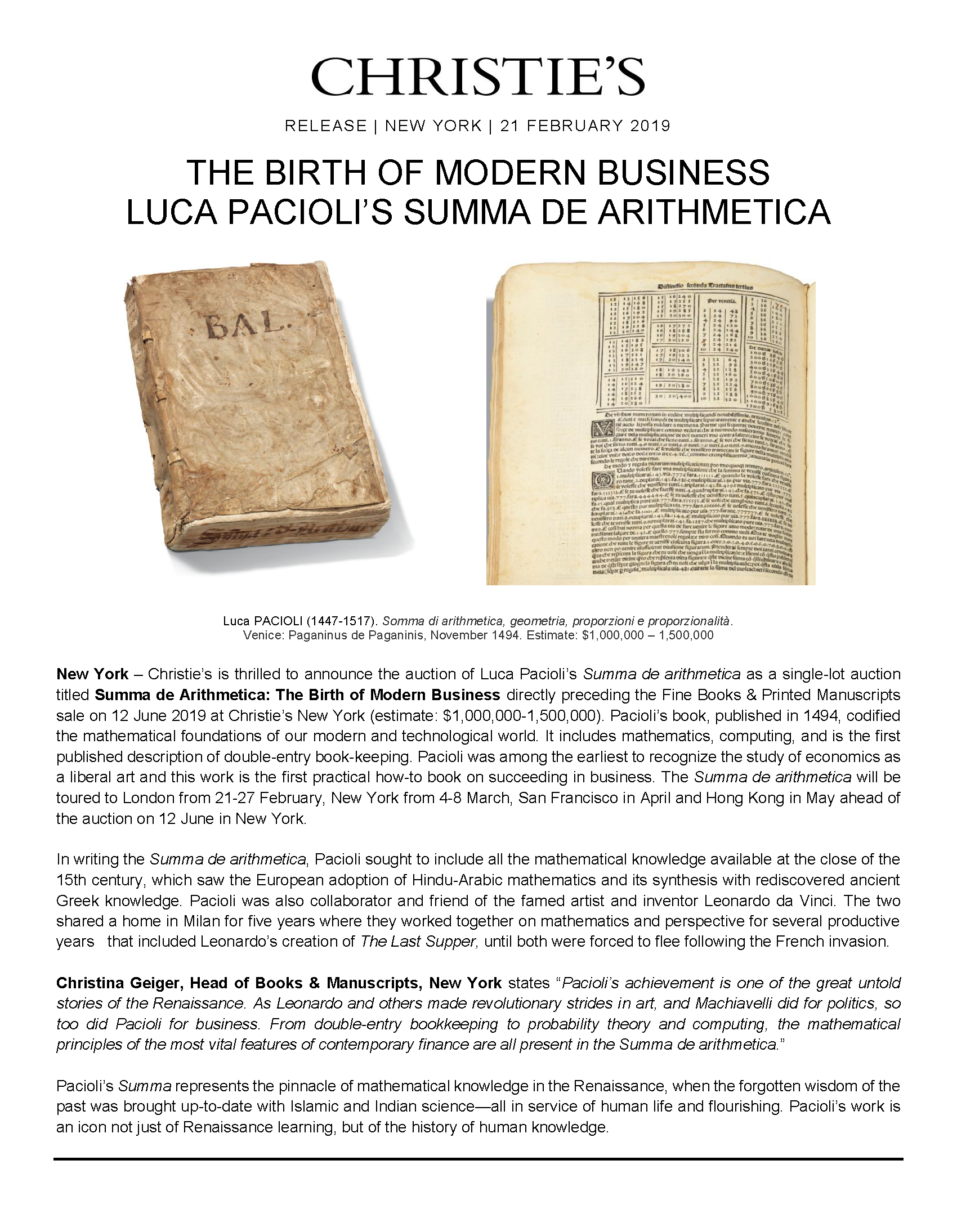Summa de Arithmetica - a landmark in the development of the modern world
By Keith Devlin @profkeithdevlin
FOR SALE, ARITHMETIC TEXTBOOK, USED, GOOD CONDITION. DETAILS BELOW.
Okay, with an expected sale price at auction of $1M to $1.5M, this is not your typical, used, math textbook. In fact, you can get a sense of the anticipated buyer by the title of the sale: the subtitle of Luca Pacioli’s book is “Summary of arithmetic, geometry, proportions and proportionality”, but for the sale announcement Christie’s (who are experts in handling sales of this kind of work) replaced that phrase by “the birth of modern business”.
There is no shortage of mathematicians who have made fortunes as quants in the financial markets over the past few decades, who have the monetary resources to indulge their love of mathematics to the extent of acquiring a first print of one of the most influential mathematical works of all time. (Only 120 or so first edition copies are known to exist. The copy on sale appears to be from the second of three printings, dated around 1502.) I have to admit, I would love to hold it in my hands for a while, as I did two early (hand-written) copies of Leonardo Fibonacci’s Liber abbaci, when I was researching my books The Man of Numbers, Finding Fibonacci, and Leonardo and Steve. Owning it, not so much—but if I were in a position where a million dollars were small change, maybe I’d feel differently.
Be that as it may, Christie’s sale-oriented title is absolutely not inaccurate, any more than my subtitle for Finding Fibonacci: “The Quest to Rediscover the Forgotten Mathematical Genius Who Changed the World ”, or the publisher’s catalogue summary of The Man of Numbers, which I approved: “The untold story of Leonardo of Pisa, the medieval mathematician who introduced Arabic numbers to the West and helped launch the modern era.” (Emphasis added in both cases.) Those works by Leonardo and Pacioli really did change the course of history.
Pacioli’s book Summa de Arithmetica was in fact the next major mathematical publication landmark after Leonardo Pisano in the development of the modern commercial and financial world. In fact, as I described in both those Fibonacci books, were it not for Pacioli acknowledging in his introduction that his treatment of Hindu-Arithmetic followed that of Leonardo, we would likely never have known of the role the thirteenth century Pisan and his book Liber abbaci played in that major historical development.
Both Liber abbaci and Summa de Arithmetica were as much business books as they were mathematics texts. In Finding Fibonacci, most of Chapter 15 is devoted to the work of William Goetzmann, Professor of Finance in the Yale School of Management, who wrote:
“The five-hundred-year period following the appearance of Liber abbaci saw the development in Europe of virtually all the tools of financial capitalism that we know today: share ownership of limited-liability corporations, long-term government and corporate loans, liquid and active international financial markets, life insurance, life-annuities, mutual funds, derivative securities, and deposit banking. Many of these developments have their roots in contracts that were based on the mathematical analyses Leonardo introduced to Western Europe through Liber abbaci.”
As I noted already, Pacioli was a major part of that commercial thread. As the first printed book on algebra in a vernacular language, and being written by a respected, established mathematician, Summa reached a far wider and more influential audience than any of the earlier, handwritten manuscripts of Leonardo and others.
It was also the first printed book to codify and give a comprehensive explanation of modern, double-entry bookkeeping, a system of accounting with a long history going back to Jewish bankers in Cairo in the eleventh century (maybe earlier), and used by Italian merchants and bankers, including the Medicis in Florence, throughout the fourteenth and fifteenth centuries.
Summa did for accounting what Liber abbaci did for Hindu-Arabic arithmetic: it made it go mainstream, presenting it in a way that enabled ordinary people (at least those with some facility with numbers) to master the mathematical techniques required for finance and commerce. For that reason, Pacioli is sometimes referred to as “the father of accounting.”
But as with Liber abbaci, Summa was more than a business person’s “how to” manual. Both were scholarly mathematical texts, written in the rigorous logical fashion of Euclid’s Elements.
Summa consists of ten chapters covering essentially all of Renaissance mathematics. The first seven chapters form a summary of arithmetic; chapter 8 explains contemporary algebra (initiating the use of logical argumentation and theorems in studies of the subject); chapter 9 covers various topics relevant to business and trade (including barter, bills of exchange, weights and measures, and bookkeeping); and chapter 10 describes practical geometry and trigonometry.
None of the methods described are due to Pacioli himself; his contribution, which was significant, was the comprehensive, comprehensible exposition. Something I have spent a large part of my mathematical career focusing on.
The significance of good expositions, and more recently well-designed technologies, in ensuring the new ideas and methods “change the world” is the focus of my short book Leonardo and Steve, referred to earlier. The “Steve” is Steve Jobs. Pacioli was a talented polymath, and a collaborator of Leonardo Da Vinci, who did many things. But it was his Summa that had a major influence in the development of modern society. That’s why his book is a major historical artifact.
For some wonderful images of pages from Pacioli’s Summa, see this MAA webpage from 2011.
For details of Pacioli and his other works, his Wikipedia entry provides an excellent summary.
ADDENDUM: For those of you in the San Francisco Bay Area, I will be giving a short talk about Pacioli’s Summa at a showing of the manuscript on sale, being organized by Christie’s in San Francisco on April 24 from 6:00 to 8:00pm
Read the Devlin’s Angle archive.

